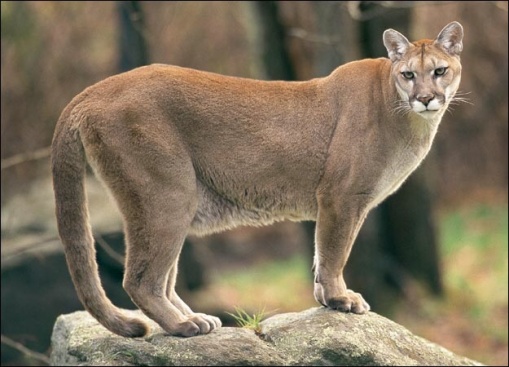The cougar is native to the Americas, particularly south America and western North America and is often known by other names such as mountain lion, puma and panther. Cougars can be found mainly in the mountain regions of Canada and Mexico, but as the name cougar is often used to describe an un-spotted leopard. The cougar is the fourth biggest feline in the world behind the lion, tiger and jaguar, making the cougar the second largest cat in the Americas. The cougar has longer back than front legs and a long heavy body. Unlike other big cats, however, the cougar cannot roar. Instead, the large feline purrs like a house cat.
Cougars also have similar body types to house cats, only on a larger scale. They have slender bodies and round heads with pointed ears. They vary between 1.5-2.7 m (5-9 ft.) from head to tail. While males can weigh up to 68 kg (150 lb.), females weigh less, topping out at nearly 45 kg (100 lb.).
The coat of the cougar is a grayish tan to reddish color with lighter parts on the underside. The tail has a black spot on the end.
Inhabiting various ecosystems from mountains to deserts to sea-level, the cougar’s range includes western North America, a small region in Florida, and most of South America. They make their home anywhere that there is shelter and prey.
Food
Generally they prey on large mammals such as moose, deer, elk and stray wolves and can often go for long periods of time without food. They are also known to feed on smaller animals if necessary, including domestic animals and livestock. Cougars have even been known to eat insects. Skilled and cunning hunters, cougars stay hidden from their prey until they can pounce with claws out-stretched. Cougars can also climb with ease and leap over 6 m (20 ft.). After killing a large animal, a cougar hides the carcass and eats in the coming days.
For the most part, the cougar has no natural enemies and sits atop the food chain. However, they occasionally compete with other predators such as bears and wolves for food.
During most of their lives, cougars are solitary creatures. They interact only to mate, which can happen at any time of year. Females can breed as early as 2-3 years old and give birth to 2-3 kittens at a time. They raise the young while the males return to their solitary lifestyles.
At around two years old, cougar offspring will leave their mother to start their own life. Some travel far to establish their own territory as cougars need a lot of room to roam.
A healthy cougar in the wild can live to around 10 years of age. In captivity, cougars can live as long as 20 years.
Conservation Status
Cougars have been long been killed by both sport hunters and farmers protecting their livestock. Other threats to cougar populations include habitat loss and fragmentation and automobile accidents. As a result, the cougar population has significantly decreased.
Although they once ranged throughout North and South America, they are no longer found in the eastern portion of the United States and Canada, the exception being a small population in Florida. The subspecies known as the Florida panther is considered to be critically endangered, and agencies are working to maintain the current population. There are still, however, several thousand cougars in the wild, and as a result, they listed as being of ‘least concern’ on the IUCN Red List.
What You Can Do To Help
It is difficult to stop habitat loss or reverse its effects, but there are some ways you can help. You can help persuade your congressperson to designate the cougar as a protected animal. This legally prevents the taking or injuring of cougars, unless they pose a threat. This law has been in effect in the state of California since the approval of Proposition 117 in 1990.
You can also appeal to your congressman or woman advocating the preservation of open land in order to maintain a livable habitat for cougars. In addition, you can donate directly to the Mountain Lion Foundation.
Cougar Distribution
Pumas are the most widespread of the American cats and have the largest distribution of any mammal in the western hemisphere. These large slender cats are found across a diverse range of habitats, from arid desert to cold coniferous forest, and although terrestrial, can swim and climb trees when they need to. Pumas are powerful predators and hunt by stalking and ambushing their prey. However, if ill or young, they themselves can become lunch for hungry wolves or bears. They hold the record for the mammal with the most common names – over 40 in English alone.
Inhabiting various ecosystems from mountains to deserts to sea-level, the cougar’s range includes western North America, a small region in Florida, and most of South America…
Cougar Resources
Mountain Lion Foundation
National Geographic – Mountain Lion
The San Diego Zoo – Mountain Lion (Puma, Cougar)
IUCN Red List – Puma concolor
Blog Posts about the Cougar
Featured Animal: Cougar (aka Mountain Lion) – September 30, 2013
Baby Cougars at the Cincinnati Zoo – November 19, 2010
Florida Panther Population Running Out of Room – December 21, 2008
New Additions to Animal Fact Guide – December 7, 2008
Did you know?
The puma has more common names than any other mammal.
Cougar distribution map worldwide.
***














